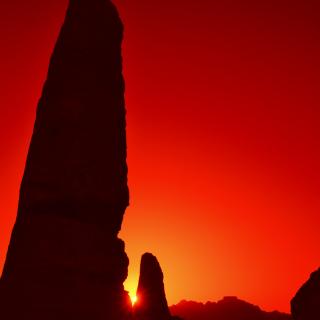Esteban, C.; Ocharan Ibarra, J. A.
Bibliographical reference
Lucentum. 2018, 37: 93-106.
Advertised on:
5
2018
Refereed citations
0
Description
Presentamos un estudio arqueoastronómico de dos santuarios rupestres situados en abrigos rocosos, Cueva del Rey Moro y Cueva Negra. Cueva del Rey Moro es un santuario ibérico asociado al poblado de Castellar de Meca. Aunque descartamos resultados anteriores que proponían la orientación del núcleo del santuario hacia el ocaso del solsticio de verano, encontramos dos posibles marcadores de ocaso solar en el día mitad entre solsticios (fecha cercana al equinoccio) y en el solsticio de verano en sendos cerros del horizonte occidental. Cueva Negra fue un importante lugar de culto en época romana como atestiguan los tituli picti encontrados en su interior, aunque también se evidencia su uso cultual durante época ibérica. Nuestro estudio indica la existencia de un marcador muy preciso del día mitad entre solsticios sobre la ladera de la Sierra de Abanilla, aunque sin duda, el resultado más interesante es que el orto solar sobre la cumbre puntiaguda de dicha sierra, el pico Zulum, se produce, en la actualidad, el 27 de marzo, justamente la fecha del calendario juliano que se recoge en varias inscripciones de los tituli picti, y que podría corresponder con la festividad de la lavatio de la Magna Mater. Este espectacular orto pudo haberse utilizado como marcador de la fecha de la celebración principal del santuario romano si las inscripciones (al menos aquellas que muestran dicha fecha) hubieran sido realizadas durante el siglo III d.C., pues en ese siglo las fechas de los calendarios juliano y gregoriano actual coincidieron. Este resultado es consistente con los valores bajos de la horquilla de datación paleográfica propuesta para las inscripciones. | We present an archeoastronomical study of two sanctuaries located in rocky shelters containing water springs, Cueva del Rey Moro and Cueva Negra. Cueva del Rey Moro is an Iberian sanctuary associated with the settlement of Castellar de Meca. We discard previous published results that proposed the orientation of the nucleus of the sanctuary towards the summer solstice sunset. We find two possible markers of the sunset at the half-day in time between solstices (a date close to equinox) and at the summer solstice over the hills located in the western horizon. Cueva Negra is very close to the Roman baths of Fortuna and was an important place of worship in the Roman period, as evidenced by the tituli picti found inside. There is also evidence of its use as a place of worship in Iberian times. Our study indicates the existence of a very precise marker of the half-day in time between solstices on the slope of the Sierra de Abanilla. However, the most remarkable result we found in Cueva Negra is that the sunrise over the pointed summit of the Sierra de Abanilla, the Zulum peak, occurs on March 27, which is the date of the Julian calendar that appears in several of the tituli picti, and that could correspond to the festivity of the lavatio of the Magna Mater. This spectacular sunrise may have been used as a marker for the date of the main celebration of the Roman sanctuary if the inscriptions (at least those showing that date) were made during the third century AD, because in that century the dates of the Julian and current Gregorian calendar coincided. This result is consistent with the low values of the dates given by the palaeographic dating proposed for the inscriptions.
Related projects

Archaeoastronomy
The main objective of this project is to study the importance of astronomy as a fundamental part of human culture and civilization from Paleolithic to the present day. Our interest is mainly devoted to the people of the ancient Mediterranean cultures from the Atlantic to the Middle East, with a special dedication to Spain, its geographical
Juan Antonio
Belmonte Avilés